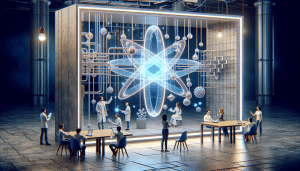AI Tools That Are Quietly Reshaping Your Every Day
Aiden Foster September 4, 2025
Artificial intelligence has started transforming the way people work, interact, and solve problems—often in surprising ways. Uncover how AI-driven tools are quietly woven into daily life, powering innovations from smart speakers to automated healthcare, and learn what’s behind their rapid adoption.
The Subtle Emergence of Artificial Intelligence
Artificial intelligence is no longer an abstract concept limited to research labs. AI-powered solutions are everywhere, from predictive text in messaging apps to algorithmic recommendations in streaming platforms. For many, these advancements happen behind the scenes, seamlessly improving convenience and efficiency. Most people benefit from AI innovation daily, often without realizing its influence. Algorithms assess preferences, traffic flows, and even medical risks, quietly driving the evolution of modern society.
The rise of AI tools in daily life is driven by advances in machine learning, natural language processing, and computer vision. These technologies allow digital assistants, voice-powered devices, and intelligent chatbots to offer real-time help, personalized answers, and enhanced accessibility. While some applications are obvious, such as smart home hubs reacting to voice commands, others operate invisibly—like spam filters, fraud detection systems, and automated translation engines working tirelessly in the background.
What’s shaping the rapid growth of AI technologies? High demand for real-time information, personalized content, and increased automation fuels relentless research and development. Organizations turn to AI systems to improve productivity, maintain competitiveness, and streamline decision-making. As these tools mature, they become easier to adopt, meaning the everyday integration of artificial intelligence will only accelerate.
Surprising Ways You Use AI in Daily Life
From the moment a smartphone is unlocked with facial recognition, AI steps in. Commuters rely on AI-driven navigation apps that calculate routes based on traffic data, user habits, and environmental factors. Health trackers leverage advanced algorithms to analyze sleep patterns, count steps, and monitor heart rates, providing actionable feedback for overall well-being. Even simple online searches are powered by machine learning, tailoring results to users’ intent and context.
Home environments are increasingly shaped by AI-powered assistants. Tools like voice-activated smart speakers manage schedules, answer questions, and control appliances. Machine learning in image recognition makes photo curation effortless, with devices automatically categorizing memories by people, places, or objects. Email programs use sophisticated AI filters to organize messages and reduce clutter, while advanced security systems use AI to spot suspicious activity.
Behind the scenes, AI-driven automation processes financial transactions, manages logistics, and calibrates energy use in smart grids. Many businesses automate repetitive tasks using AI bots, freeing up human time for more creative or strategic work. These layers of invisible assistance show how AI, often unrecognized, continuously improves convenience, safety, and efficiency across diverse domains.
AI-Powered Healthcare: Quiet Revolution
Healthcare is one area where AI tools are gaining ground with less fanfare but huge impact. Machine learning models analyze medical records, predict disease risks, and assist clinicians with diagnosis (Source: https://jamanetwork.com/journals/jama/fullarticle/760769). Algorithms review imaging studies faster than ever before, flagging anomalies and enabling earlier intervention. Chatbots and virtual agents answer patient questions day or night, reducing the burden on human staff while enhancing access.
Electronic health records (EHR) rely on AI to ensure accurate coding, identify incomplete documentation, and detect potential safety issues. Remote monitoring tools use AI to interpret patient-generated health data, alerting practitioners to warning signs before crises develop. This blend of automation and analytics leads to more proactive, personalized medical care, improving both outcomes and system efficiency (Source: https://www.ncbi.nlm.nih.gov/pmc/articles/PMC6616181/).
Research into predictive analytics, digital therapeutics, and AI-powered drug discovery is reshaping the healthcare landscape. These developments promise not only better disease management, but also new approaches to prevention and population health. While skepticism about AI remains, the growing body of real-world results highlights its vast potential for supporting patient-centric care (Source: https://www.healthit.gov/topic/scientific-initiatives/precision-medicine).
The Science Behind Intelligent Automation
At the heart of artificial intelligence lies machine learning: the science of enabling software to identify patterns, adapt to new input, and perform tasks without being explicitly programmed for every possibility. Massive datasets feed advanced algorithms, empowering systems to continuously refine their understanding. Natural language processing allows computers to interpret, generate, and respond to human language. Computer vision teaches machines to identify objects, decipher scenes, or translate text from images or videos.
Neural networks, inspired by the human brain, enable deep learning—a type of machine learning that excels at recognizing complex structures in data. These architectures make it possible to achieve breakthroughs in image classification, speech recognition, and even creative endeavors such as painting or composing music. Robotics brings artificial intelligence to the physical world, combining sensory input, planning, and action. In manufacturing, autonomous robots optimize workflow, ensure safety, and minimize downtime through smart adaptation (Source: https://www.nist.gov/topics/artificial-intelligence).
Understanding the technical foundation helps demystify why AI impacts so many aspects of modern life. Ongoing research focuses on explainable AI, ethical use, and reducing bias—ensuring that innovation aligns with societal values. As more sectors adopt AI for analytics, automation, and decision support, a basic grasp of its inner workings becomes essential for appreciating both its promise and limitations.
AI’s Role in Communication and Media
AI tools are transforming how information is discovered, curated, and shared. Recommendation engines sift through vast content libraries to bring readers personalized news, music, or videos—adapting constantly to individual preferences. Social media platforms rely on machine learning algorithms to surface relevant posts and manage user safety, using AI to identify harmful language or misleading content (Source: https://knightcolumbia.org/content/algorithms-and-automated-content-moderation).
Content creation itself is being revolutionized by AI-powered tools. Automated captioning on video platforms improves accessibility. Language models generate initial text drafts, flag errors, or suggest improvements—supporting both efficiency and creativity. Media organizations use AI to fact-check claims or detect image manipulation. Journalists leverage data analysis tools to uncover trends and visualize complex topics for a broader audience.
Improved translation and real-time transcription make global communication smoother than ever. These achievements bridge linguistic divides and level the playing field for international collaboration. As digital content explodes, AI’s ability to distill, summarize, and deliver meaning becomes increasingly valuable to those seeking clarity in a noisy world.
Balancing Innovation and Ethical Concerns
The power of artificial intelligence brings fresh challenges. Users and developers alike must grapple with issues of transparency, accountability, and privacy. AI systems, for all their efficiency, sometimes make decisions that are opaque—and errors or biases are amplified when left unchecked (Source: https://www.nap.edu/read/25104/chapter/1).
Regulatory frameworks for AI governance are developing, with policymakers working to safeguard data and prevent misuse. Guidelines emphasize fairness, non-discrimination, and the ability for humans to understand or challenge automated decisions when needed. Industry leaders now prioritize responsible AI development, investing in robust testing and bias mitigation. AI literacy, or the ability to discern how AI influences daily experiences, becomes vital as technology advances.
Building trust in intelligent systems requires open dialogue. Engaged citizens, thoughtful regulation, and ethical research together ensure that AI charts a course aligned with broader human values. The conversation around responsible innovation remains dynamic, seeking to maximize benefits while addressing real concerns.
References
1. Topol, E. J. (2019). High-performance medicine: the convergence of human and artificial intelligence. JAMA, 321(6), 507-508. Retrieved from https://jamanetwork.com/journals/jama/fullarticle/760769
2. Jiang, F., Jiang, Y., Zhi, H., Dong, Y., Li, H., Ma, S., … & Wang, Y. (2017). Artificial intelligence in healthcare: past, present and future. Stroke and Vascular Neurology, 2(4), 230-243. Retrieved from https://www.ncbi.nlm.nih.gov/pmc/articles/PMC6616181/
3. U.S. Department of Health and Human Services. (n.d.). Precision Medicine Initiative. Retrieved from https://www.healthit.gov/topic/scientific-initiatives/precision-medicine
4. National Institute of Standards and Technology. (n.d.). Artificial Intelligence. Retrieved from https://www.nist.gov/topics/artificial-intelligence
5. Knight First Amendment Institute. (2019). Algorithms and Automated Content Moderation. Retrieved from https://knightcolumbia.org/content/algorithms-and-automated-content-moderation
6. National Academies of Sciences, Engineering, and Medicine. (2019). Artificial Intelligence and Ethics. Retrieved from https://www.nap.edu/read/25104/chapter/1








